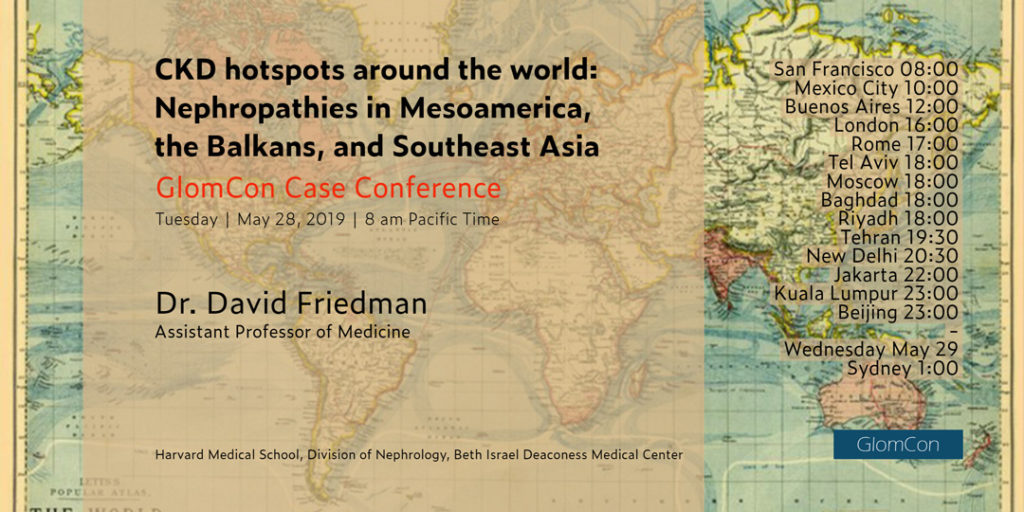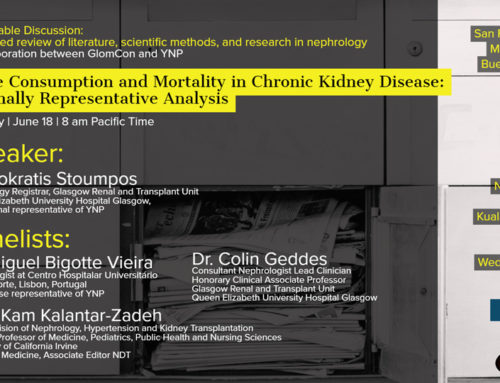CHRONIC KIDNEY DISEASE
CKD Hotspots around the world: Nephropathies in Mesoamerica, the Balkans and Southeast Asia
In this GlomCon Conference, Dr. David Friedman discussed the epidemiology and associated risk factors of CKDu (CKD of unknown etiology). Our Moderator’s Notes are derived from his live presentation.


By Dr. Jorge Castaneda
Key points:
“CKD Hotspots”: While there is no standard definition for “CKD Hotspots”, Dr. Friedman explained it as well circumscribed, small endemic areas within a country (or even towns within a region of a country) where rates of CKD are many fold higher than expected. Further, in these “hotspots,” CKD is particularly severe and does not appear to be associated with the traditional risk factors such as diabetes.
It is likely that there are many “CKD hotspots” around the world, but the most well-described phenomena and locations include Mesoamerican Nephropathy, CKDu in Sri Lanka,and Balkan Nephropathy.
Mesoamerican Nephropathy (MeN)
1.- Epidemiology
• Most common in young men (up to 40% of men in some communities).
• Agricultural cultures but other manual labors involved (miners, brick makers).
• Primarily in the Pacific Coast of Central America (low altitude regions).
2.-Clinical Characteristics:
Consistent:
• Presents with advanced CKD.
• Biopsy findings consistent with tubulointerstitial disease. However, a glomerular component has also been described.
• Small echogenic kidneys.
Frequent:
• Hyperuricemia
• Family history
Sometimes:
• Hyponatremia
• Hypokalemia
• Hypomagnesemia
• Leukocyturia
• ‘Chistata’ (dysuria and sensation of gravel in the urine, but culture negative)
• NSAID use (but link unclear)
Progression Rates
The majority of people affected present with a slow decline in renal function. A small subgroup, however, experiences a more rapid progression, leading to ESRD within a few years.
Acute Presentation (reference #3)
• Some asymptomatic agricultural workers do present with elevated serum creatinine by the end of one single harvest season.
•
4.-Biopsy Findings:
• Primarily a tubulointerstitial pattern of tissue injury, similar to interstitial nephritis, with inflammatory cell infiltrates, tubulitis, and intratubular WBC casts.
• Occasional intracytoplasmic inclusion bodies, vacuoles in podocytes, some resembling zebra-bodies, remain a puzzle.
6.- Etiology:
The etiology remains a mystery. Many factors are being considered, and several were discussed by Dr. Friedman during the session. A baseline genetic predisposition (familial clustering) together with environmental factors, such as minerals, human-made toxins or infections seems likely, yet remains to be proven.
Sri Lanka: Chronic Interstitial Nephritis of Agricultural Communities (“CINAC”)
1.- Epidemiology
As the name implies, CINAC primarily affects agricultural workers in selected communities in Sri Lanka and affects a large proportion of the young population there. Similar to Mesoamerican Nephropathy, the pathology is that of tubulointerstitial nephritis. However, many differences in the conditions were highlighted, such as gender distribution, different association with environmental and lifestyle factors.
2.- Etiology
• While many potential causes have been postulated (agricultural toxins, environmental factors, genetics, etc.,) the etiology remains unknown. Genome-wide association studies have suggested a possible role of genetic polymorphism in a renal organic anion transporter (suggesting genetically predisposed impairment in handling extrinsic toxins).
3.- Biopsy
• Very similar to Mesoamerican nephropathy, a pattern of tubulointerstitial nephritis with occasional intracytoplasmic inclusion bodies.
Balkan Nephropathy
Aristocholic Acid nephropathy
Most common in South-east Europe
Kidney biopsy with interstitial fibrosis, tubular atrophy, glomerular sclerosis
High risk of urothelial cancers
Selected References
1.- https://www.ncbi.nlm.nih.gov/pubmed/28126239
2.-https://www.ncbi.nlm.nih.gov/pubmed/23850447
3.- https://www.ncbi.nlm.nih.gov/pubmed/30042041
4.- https://www.ncbi.nlm.nih.gov/pubmed/30659059
5.- https://www.ncbi.nlm.nih.gov/pubmed/24351856
6.- https://www.ncbi.nlm.nih.gov/m/pubmed/31054628


